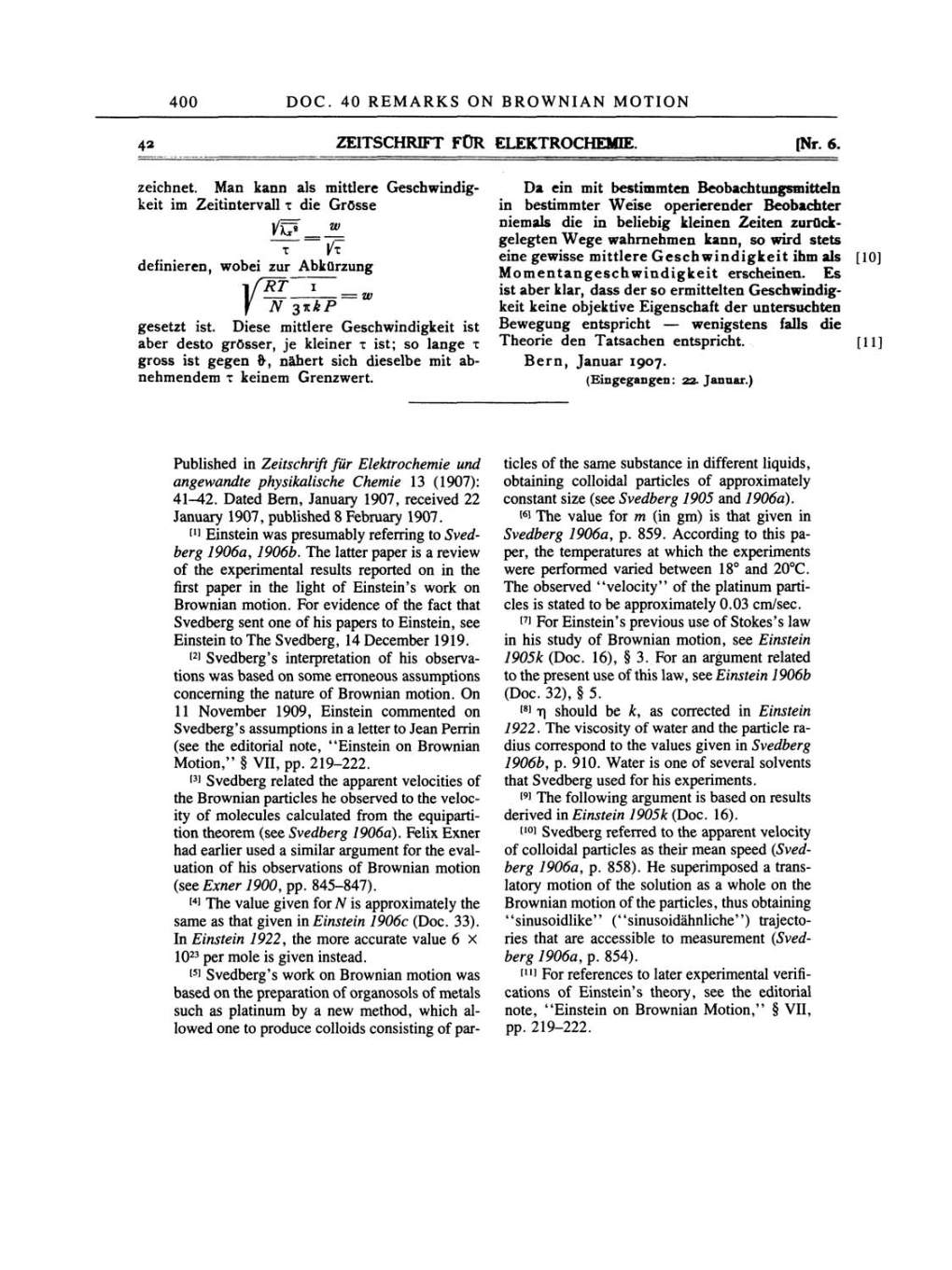400
DOC.
40
REMARKS
ON
BROWNIAN MOTION
42
ZEITSCHRIFT FÜR ELEKTROCHEMIE.
[Nr.
6.
zeichnet.
Man
kann als mittlere
Geschwindig-
keit
im
Zeitintervall
t
die Grösse
vi?
T
]/x
definieren,
wobei
zur
Abkürzung
N 3*kP
w
gesetzt
ist. Diese mittlere
Geschwindigkeit
ist
aber
desto
grösser, je
kleiner
t
ist;
so
lange
t
gross
ist
gegen q,
nähert
sich
dieselbe
mit ab-
nehmendem
t
keinem
Grenzwert.
Da ein mit bestimmten
Beobachtungsmitteln
in
bestimmter Weise
operierender
Beobachter
niemals die
in beliebig
kleinen Zeiten zurück-
gelegten Wege
wahrnehmen
kann,
so
wird
stets
eine
gewisse
mittlere Geschwindigkeit
ihm
als
[10]
Momentangeschwindigkeit erscheinen. Es
ist aber
klar,
dass der
so
ermittelten
Geschwindig-
keit keine
objektive Eigenschaft
der untersuchten
Bewegung entspricht
-
wenigstens
falls
die
Theorie den Tatsachen
entspricht.
[11]
Bern,
Januar
1907.
(Eingegangen:
22.
Januar.)
Published
in
Zeitschrift
für Elektrochemie und
angewandte
physikalische
Chemie
13 (1907):
41-42.
Dated
Bern,
January
1907,
received 22
January 1907,
published
8
February
1907.
[1]
Einstein
was
presumably referring
to Sved-
berg 1906a, 1906b. The latter
paper
is
a
review
of
the
experimental
results
reported on
in the
first paper in the
light
of Einstein's
work
on
Brownian
motion.
For
evidence
of
the fact that
Svedberg
sent
one
of
his
papers
to
Einstein, see
Einstein to The
Svedberg, 14
December 1919.
[2]
Svedberg's
interpretation
of
his observa-
tions
was
based
on
some
erroneous
assumptions
concerning
the nature
of
Brownian motion. On
11
November
1909,
Einstein commented
on
Svedberg's
assumptions
in
a
letter to Jean Perrin
(see
the editorial note,
"Einstein
on
Brownian
Motion,"
§
VII,
pp.
219-222.
[3]
Svedberg
related the
apparent
velocities of
the Brownian
particles
he observed
to
the veloc-
ity
of
molecules calculated from the
equiparti-
tion
theorem
(see Svedberg 1906a).
Felix Exner
had
earlier
used
a
similar
argument
for the eval-
uation
of
his
observations
of
Brownian motion
(see
Exner
1900,
pp.
845-847).
[4]
The value
given
for N is
approximately
the
same as
that
given
in Einstein 1906c
(Doc. 33).
In
Einstein
1922,
the
more
accurate value
6
x
1023
per
mole is
given
instead.
[5] Svedberg's
work
on
Brownian motion
was
based
on
the
preparation
of
organosols
of
metals
such
as platinum by a new method,
which al-
lowed
one
to
produce
colloids
consisting
of
par-
ticles
of
the
same
substance in different
liquids,
obtaining
colloidal
particles
of
approximately
constant size
(see Svedberg
1905 and 1906a).
[6]
The
value for
m (in gm)
is that
given
in
Svedberg
1906a,
p.
859.
According
to this
pa-
per,
the
temperatures
at
which the
experiments
were
performed
varied between
18°
and 20°C.
The observed
"velocity"
of
the
platinum parti-
cles is stated to be
approximately
0.03
cm/sec.
[7]
For
Einstein's
previous
use
of Stokes's
law
in his
study
of
Brownian
motion,
see
Einstein
1905k
(Doc. 16),
§
3. For
an argument
related
to
the
present use
of this
law,
see
Einstein 1906b
(Doc. 32),
§
5.
[8]
n should be
k, as
corrected in Einstein
1922. The
viscosity
of
water
and the
particle ra-
dius
correspond
to the values
given
in
Svedberg
1906b,
p.
910. Water is
one
of
several solvents
that
Svedberg
used
for
his
experiments.
[9]
The
following argument is
based
on
results
derived
in
Einstein
1905k
(Doc. 16).
[10] Svedberg
referred to the
apparent velocity
of
colloidal
particles as
their
mean speed
(Sved-
berg
1906a,
p.
858).
He
superimposed a
trans-
latory
motion
of
the solution
as a
whole
on
the
Brownian
motion
of
the
particles,
thus
obtaining
"sinusoidlike"
("sinusoidähnliche")
trajecto-
ries that
are
accessible to measurement
(Sved-
berg
1906a,
p.
854).
[11]
For references to later
experimental
verifi-
cations
of Einstein's
theory,
see
the editorial
note,
"Einstein
on
Brownian Motion,"
§
VII,
pp.
219-222.
